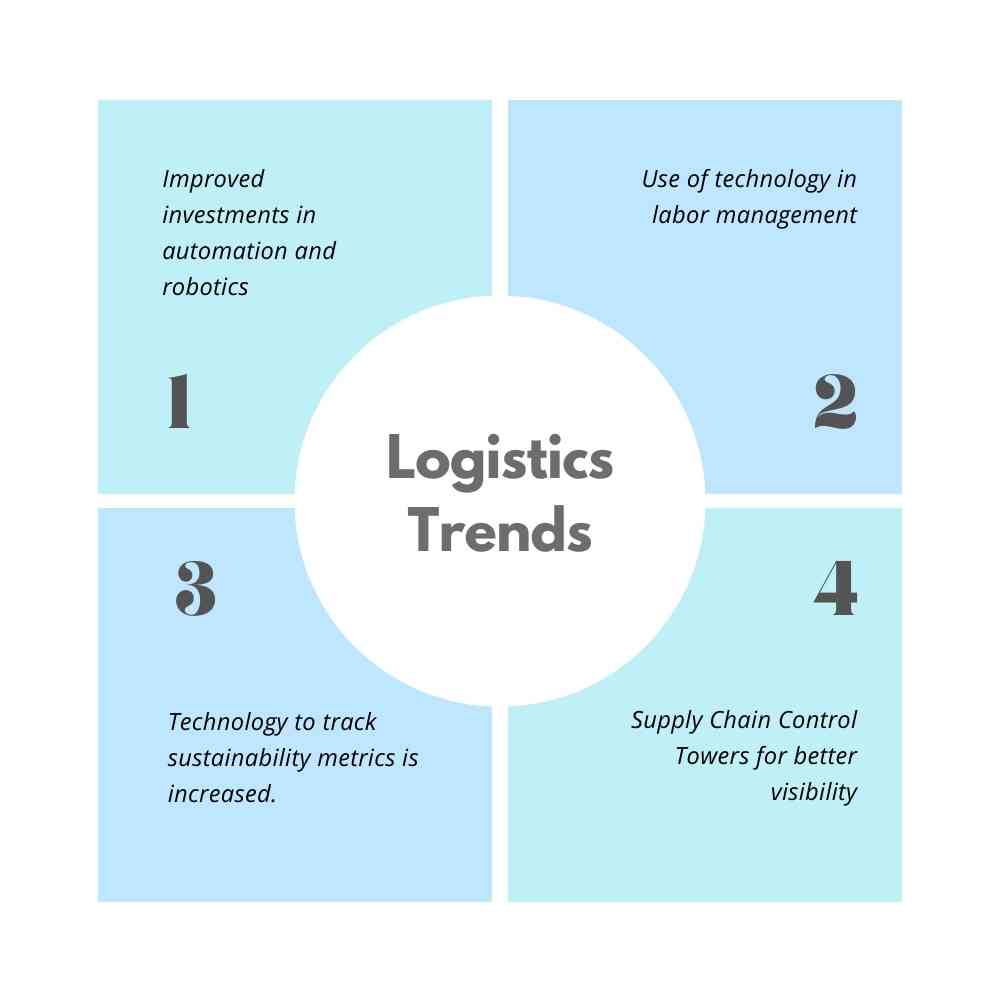After the pandemic, an increase in operations and growth of logistics companies led to an increased interest from private equity firms. It was due to the rapid expansion of these businesses and owners looking to sell while valuations were at all-time highs.
The economic situation also affected merger and acquisition activity: labor shortages encouraged organizations to pursue inorganic development agendas, and rising interest rates made buyers wary of buying companies with high debt loads.
Sellers were still attached to the prior record valuation of their businesses. Still, buyers considered recent drops in pricing, rising interest rates, and several concerning economic predictions.
The value of sustainability has become more critical now, and it is influencing how materials are managed. Organizations seek ways to cut waste and redefine “asset management” through technology. Before we jump into trends, let’s see what are the operations in logistics management.
Here we have the most common list of operations in logistics:
- Demand Forecasting
- Inventory Management
- Order Processing
- Warehousing
- Transportation Management
- Route Optimization
- Freight Forwarding
- Customs Clearance
- Packaging and Labeling
- Cross-Docking
- Material Handling
- Supplier Relationship Management
- Reverse Logistics
- Last-Mile Delivery
- Supply Chain Visibility
- Risk Management
- Carrier Selection
- Freight Consolidation
- Yard Management
- Distribution Center Management
Following Trends in Technologies for Logistics

Let’s see the trends in more detail way.
Supply Chain Control Towers for better visibility
A centralized platform or system gives firms enhanced visibility, coordination, and control over their end-to-end supply chain processes. This technology-driven solution utilizes real-time data, analytics, and advanced technologies like artificial intelligence (AI) to gather, process, and analyze information from various supply chain stages.
Key benefits of Supply Chain Control Towers include:
Real-time Visibility: Organizations gain real-time data and insights access, enabling them to make decisions quickly and proactively address potential issues.
Predictive Analytics: AI and machine learning control towers can predict disruptions and suggest strategies to mitigate risks before they escalate.
Collaboration and Communication: Control towers facilitate improved communication and foster better coordination and alignment.
Efficiency and Optimization: By identifying bottlenecks, delays, and areas of inefficiency, organizations can optimize their processes, enhance overall supply chain performance, and decrease costs.
Improved integration abilities of logistics software
Enhanced integration capabilities of logistics software refer to the advanced ability of logistics management software to seamlessly connect and communicate with various systems, platforms, and data sources within the supply chain ecosystem. This improved integration empowers businesses to optimize logistics operations by facilitating real-time data sharing, process automation, and efficient collaborations.
Improved investments in automation and robotics
Increased investments in automation and robotics refer to the growing trend of allocating financial resources toward developing, implementing, and utilizing advanced technological solutions in various industries. It involves using automation technologies, such as artificial intelligence (AI) and robotics, to streamline processes, enhance efficiency, and reduce the need for human intervention in tasks traditionally performed manually. These investments aim to improve production, quality, and operational speed while lowering labor costs.
Use of technology in labor management
Technology in labor management refers to incorporating various technological tools and systems to optimize and streamline organizational workforce management. It involves the application of software, hardware, and data-driven solutions to enhance productivity, communication, scheduling, performance tracking, and overall efficiency in human resource management. Technology enables employers to effectively allocate tasks, monitor employee performance, facilitate communication, and make data-driven decisions to improve workforce outcomes.
Technology to track sustainability metrics is increased.
The utilization of technology to monitor and measure sustainability metrics is experiencing a noticeable upward trend. It employs advanced digital tools and data-driven solutions to assess and quantify various environmental, social, and economic sustainability aspects.
With technologies like IoT (Internet of Things), data analytics, artificial intelligence, and ERP solutions, organizations can collect, analyze, and interpret data related to resource consumption, carbon emissions, waste management, renewable energy utilization, and other key sustainability indicators.
How can Acumatica enhance Logistics Industry?
Acumatica Cloud ERP system enhances logistics operations by providing a unified platform for streamlined communication, real-time data visibility, and efficient resource allocation. Acumatica ERP Software enables businesses to optimize their supply chain processes, reduce lead times, minimize excess inventory, and enhance overall operational efficiency through integrated modules for inventory management, order processing, transportation planning, and demand forecasting.
This results in improved decision-making, enhanced customer satisfaction, and cost savings, as organizations can accurately track shipments, monitor warehouse activities, and respond dynamically to changing market demands, ultimately elevating their logistics performance. I hope this “technology trend” is helpful to you. Are you looking for an ERP solution for your logistics business? Contact us for a customized ERP.

Vijay comes with a vast experience in ERP and enterprise solutions space with about 20 years of experience in various packaged application like Acumatica, SAP, Orion, Salesforce.com, SugarCRM and, SalesLogix.

